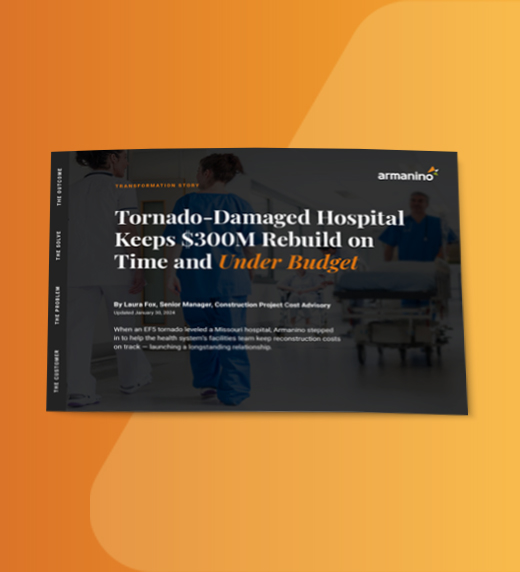
Healthcare continues to face ongoing disruption. Between staffing shortages, new regulations, pressure from insurance payers and supply chain constraints, the industry landscape is rapidly shifting. If you fail to adapt, you risk falling behind — or being rendered obsolete.
Staying on top of industry trends is critical to keep your organization cutting-edge and competitive. Here are six healthcare trends that are likely to make a major impact for years to come. Understanding these shifts, and how your organization can navigate them, will help keep you well ahead of the curve.
Digital transformation (i.e., digitally transforming your organization to meet changing stakeholder expectations and needs) has revolutionized the healthcare realm in recent years and will continue to do so for the foreseeable future. According to a recent Healthcare Information and Management Systems Society report, 80% of healthcare systems plan to increase investment in digital health solutions over the next five years. By re-thinking your strategic vision and examining how you can use technology to improve operations and modernize patient care, you lower the risk of patients seeking treatment elsewhere.
Implementing a cloud platform and a unified technology stack gives you real-time financial visibility that allows you to better manage revenue streams and costs in an ever-changing environment. Integrating cloud technology with health tech tools like artificial intelligence (AI), predictive modeling and machine learning can help you streamline workflows, maximize operational efficiencies, make sense of medical data and anticipate future challenges. Additionally, by integrating your electronic medical records (EMRs) with integral operations like patient engagement and supply chain, you can aggregate previously disconnected figures to get a holistic perspective of financial and operational data.
Having the right cloud platform in place also empowers healthcare finance teams to analyze clinical, operational and financial data to understand the true health of the organization. Vital healthcare key performance indicators (KPIs) can include cost or revenue per treatment or patient, revenue or expense per location or referral, and profit and loss by contract, budget or location. Access to this type of information lets you share details that matter and provide them to key stakeholders in real time.
Healthcare organizations are transitioning from fee-for-service to value-based care reimbursement, a model designed to reduce spend and improve patient care. However, this also means that providers’ financial performance is increasingly tied to patient outcomes. As a result, financial modeling and predictive analytics tools will become essential to sustain quality of care and protect your reimbursement. Collecting meaningful patient data — and having clear, seamless visibility into that data — will help you develop predictive modeling to better understand your organization’s current performance and pinpoint areas for improvement.
For example, if you’re a hospital finance leader, safely shortening a patient’s length of stay (LOS) is likely a strategic priority. Because quality of care is often inextricably tied to LOS, a prolonged stay for a patient can slash the reimbursement you receive. By collecting patient data on one integrated technology platform, you can get a better picture of your patient and their needs, allowing you to make healthier decisions for their quality of care and ultimately improving outcomes, reducing LOS and increasing your revenue.
Pricing transparency (i.e., disclosing detailed price information to patients and other stakeholders prior to services being rendered to allow for informed decisions about their care) is reshaping how consumers shop, and how much they pay for healthcare services.
The Transparency in Coverage final rule, issued by the Centers for Medicare & Medicaid Services (CMS) on July 1, 2022, requires group health plans and issuers of group or individual health insurance to disclose pricing information before patients receive care. This ruling follows the No Surprises Act, made effective January 1, 2022, which protects insured patients from being billed above the in-network cost sharing amount and/or the higher billed services amount for out-of-network medical care.
These two regulatory measures have substantially increased the necessity of issuing accurate and thorough up-front estimates; otherwise, your organization risks loss of revenue and non-compliance. For example, as part of the No Surprises Act, providers must supply an up-front cost estimate to patients who are uninsured or choose not to use their health insurance prior to a patient encounter, and this estimate must be within a $400 range of the final, post-treatment cost. If the estimate falls outside the designated range, a patient may be eligible to file a patient-provider dispute, and your healthcare organization could subsequently lose that expected patient revenue to fees and payouts.
To provide detailed, precise pricing transparency, it’s imperative to have the right technology in place. Deploying a comprehensive tech stack, along with industry reports and real-time dashboards, gives you a 360-degree view of patient data, treatment information, insurance coverage and contractual rates, ensuring that you are providing as accurate an estimate as possible. This in turn boosts patient satisfaction and loyalty, minimizes inaccurate patient billing and helps prevent loss of revenue.
CMS recently extended a COVID-era waiver that reimburses telehealth visits for the same amount as in-person office visits. So healthcare organizations should continue to include telemedicine and virtual care in their service offerings as they plan for the future.
Telemedicine and virtual care play an important role in providing healthcare access to individuals whose ability to get in-person access is limited, whether by ability or proximity to a healthcare location. Putting telemedicine and virtual care solutions in place and educating your patients on the benefits of using them ensures that you can keep your patient base and continue to provide quality care even without regular in-person office visits.
These measures are especially vital for providing access to care in rural communities, ensuring that patients managing chronic conditions don’t fall off the radar despite limited in-person provider access. This in turn increases quality of care and patient engagement, which subsequently boosts your revenue.
Staffing constraints will continue to be a major challenge, affecting both the clinical and administrative sides of your organization for the foreseeable future. Continued staffing shortages also mean that your remaining employees are becoming burned out as they are stretched to their limits, carrying heavier workloads and working longer hours.
Resignation across executive levels, too, has created leadership position voids, leaving organizations unable to fill specialized compliance roles like navigating healthcare fraud regulations and juggling referral arrangements.
To help curb the effects of non-clinical staffing shortages, determine whether there are any operational areas where automation is a possibility. Tools like robotic process automation (RPA) software can automate time-consuming, resource-intensive tasks such as patient registration and claim status checks, alleviating staff workloads and maximizing your internal bandwidth. Leveraging RPA for tedious, repetitive tasks empowers your employees to reallocate their time to more strategic, value-added responsibilities — and reduces risk of human error.
Additionally, identifying opportunities for outsourcing is an effective way to bridge staffing gaps. The reality of needing additional clinical staffing is well known, but are there laborious back-office tasks that could be delegated to an outside resource? Are you struggling to scale your understaffed team to keep up with growth? Outsourcing can help you supplement your in-house staff to fill vacancies and skills gaps, help you clear regulatory hurdles and give you more time to focus on your core mission.
Today’s healthcare CEOs and CFOS can no longer rely on just financial strategies to build resilient business models. Integrating your finances with an effective environmental, social and governance (ESG) strategy is critical to position your healthcare organization for future success.
ESG is a holistic approach to support sustainable development that involves operating your healthcare organization in an ethical manner with all stakeholders through this quality operating framework. Increasingly, organizations are being evaluated according to ESG standards: a set of core values and global standards for economic growth, thriving communities and a sustainable healthy environment.
You can start your ESG efforts by assessing your organization’s ESG risks and opportunities. This gives you a measurable way to reach your goals and drive meaningful growth.
The healthcare industry has been grappling with tremendous change and will continue to do so for years to come. By rethinking and redeveloping your current operations to accommodate industry trends, eliminate silos and leverage technology, you can strengthen your operations, bridge process gaps, alleviate your most pressing pain points — and position your organization for longer-term cost reduction, positive patient outcomes/experiences and patient engagement through population health.
You don’t have to navigate these changes alone. Our healthcare experts can help you harness your data and technology to make strategic, informed decisions that set you up for sustained success. To learn more, visit our Healthcare Industry page.


